Abstract
Prosthetic implants are used daily to treat edentulous people and to restore mobility in patients affected by skeletal defects. Titanium (Ti) is the material of choice in prosthetics, because it can form a stable bond with the surrounding bone following implantation—a process known as osseointegration. Yet, full integration of prosthetic implants takes time, and fails in clinical situations characterized by limited bone quantity and/or compromised regenerative capacity, and in at-risk patients. Intense research efforts are thus made to develop new implants that are cost-effective, safe, and suited to every patient in each clinical situation. In this study, we tested the possibility to functionalize Ti implants using stem cells. Human induced pluripotent stem cell-derived mesenchymal progenitor (iPSC-MP) cells were cultured on Ti model disks for 2 weeks in osteogenic conditions. Samples were then treated using four different decellularization methods to wash off the cells and expose the matrix. The functionalized disks were finally sterilized and seeded with fresh human iPSC-MP cells to study the effect of stem cell-mediated surface functionalization on cell behavior. The results show that different decellularization methods produce diverse surface modifications, and that these modifications promote proliferation of human iPSC-MP cells, affect the expression of genes involved in development and differentiation, and stimulate the release of alkaline phosphatase. Cell-mediated functionalization represents an attractive strategy to modify the surface of prosthetic implants with cues of biological relevance, and opens unprecedented possibilities for development of new devices with enhanced therapeutic potential.
Graphical Abstract







Similar content being viewed by others

References
Global Orthopedic Biomaterial Market Research Report - Forecast To 2022. Cooked Research Reports. ID: MRFR/HC/0101-CRR, December, 2015:296 pages.
Geetha M, Singh A, Asokamani R, Gogia A, et al. Ti based biomaterials, the ultimate choice for orthopaedic implants – A review. Prog Mater Sci. 2009;54(3):397–425.
Navarro M, et al. Biomaterials in orthopaedics. Journal R Soc Interface. 2008;5(27):1137–58.
Elias CN, et al. Biomedical applications of titanium and its alloys. J Metals. 2008;60(3):46–9.
Albrektsson T, et al. Osteoinduction, osteoconduction and osseointegration. The use of bone substitutes in spine surgery. Eur Spine J. 2001;10(Suppl 2):S96–101.
Bosco R, et al. Surface engineering for bone implants: a trend from passive to active surfaces. Coatings. 2012;2(3):95–119.
Jemat A, et al. Surface modifications and their effects on titanium dental implants. Biomed Res Int. 2015;2015:7917
Jonge L, et al. Organic–inorganic surface modifications for titanium implant surfaces. Pharm Res Pharm Res. 2008;25(10):2357–69.
Hacking SA, et al. Surface roughness enhances the osseointegration of titanium headposts in non-human primates. J Neurosci Methods. 2012;211(2):237–44.
Salou L, et al. Enhanced osseointegration of titanium implants with nanostructured surfaces: an experimental study in rabbits. Acta Biomater. 2015;11:494–502.
Schiegnitz E, et al. Vertical osteoconductive characteristics of titanium implants with calcium-phosphate-coated surfaces - a pilot study in rabbits. Clin Implant Dent Relat Res. 2014;16(2):194–201.
Lynch SE, et al. Effects of the platelet-derived growth factor/insulin-like growth factor-I combination on bone regeneration around titanium dental implants. Results a pilot study beagle dogs. J Periodontol. 1991;62:710–16.
Endo K, et al. Chemical modification of metallic implant surfaces with biofunctional proteins (Part 1). Molecular structure and biological activity of a modified NiTi alloy surface. Dent Mater J. 1995;14:185–98.
Nijhuis AWG, et al. Wet-chemical deposition of functional coatings for bone implantology. Macromol Biosci. 2010;10:1316–29.
Elmengaard B, et al. In vivo effects of RGD-coated titanium implants inserted in two bone-gap models. J Biomed Mater Res. 2005;75:249–55.
Schliephake H, et al. Functionalization of dental implant surfaces using adhesion molecules. J Biomed Mater Res Appl Biomater. 2005;73:88–96.
Roessler S, et al. Biomimetic coatings functionalized with adhesion peptides for dental implants. J Mater Sci Mater Med. 2001;12:871–77.
Hall J, et al. Bone formation at rhBMP-2-coated titanium implants in the rat ectopic model. J Clin Periodontol. 2007;34:444–51.
De Jonge LT, et al. The osteogenic effect of electrosprayed nanoscale collagen/calcium phosphate coatings on titanium. Biomaterials. 2010;31:2461–69.
Fischer U, et al. Transforming growth factor beta1 immobilized adsorptively on Ti6Al4V and collagen type I coated Ti6Al4V maintains its biological activity. Biomaterials. 2003;24(2631):2641.
Frosch KH, et al. Migration, matrix production and lamellar bone formation of human osteoblast-like cells in porous titanium implants. Cells Tissues Organs. 2002;170(4):214–27.
Frosch KH, et al. Autologous osteoblasts enhance osseointegration of porous titanium implants. J Orthop Res. 2003;21(2):213–23.
Frosch KH, et al. Stem cell-coated titanium implants for the partial joint resurfacing of the knee. Biomaterials. 2006;27(12):2542–9.
Herberts CA, et al. Risk factors in the development of stem cell therapy. J Transl Med. 2011;9:29.
Gilbert TW, et al. Decellularization of tissues and organs. Biomaterials. 2006;27(19):3675–83.
Mazza G, et al. Decellularized human liver as a natural 3D-scaffold for liver bioengineering and transplantation. Sci Rep. 2015;5:13079.
de Peppo GM, et al. Engineering bone tissue substitutes from human induced pluripotent stem cells. Proc Natl Acad Sci USA. 2013;110(21):8680–5.
Kasemo B, et al. Material-tissue interfaces: the role of surface properties and processes. Environ Health Perspect. 1994;102(Suppl 5):41–45.
Takahashi K, et al. Induction of pluripotent stem cells from adult human fibroblasts by defined factors. Cell. 2007;131(5):861–72.
Dahl SL, et al. Decellularized native and engineered arterial scaffolds for transplantation. Cell Transplant. 2003;12(6):659–66.
Graf BK, et al. The effect of in situ freezing on rabbit patellar tendon. A histologic, biochemical, and biomechanical analysis. Am J Sports Med. 1992;20(4):401–5.
Woods T, et al. Effectiveness of three extraction techniques in the development of a decellularized bone-anterior cruciate ligament-bone graft. Biomaterials. 2005;26(35):7339–49.
Xing Q, et al. Decellularization of fibroblast cell sheets for natural extracellular matrix scaffold preparation. Tissue Eng Part C: Methods. 2015;21(1):77–87.
Xu H, et al. Comparison of decellularization protocols for preparing a decellularized porcine annulus fibrosus scaffold. Plos One. 2014;9(1):e86723.
Lumpkins SB, Pierre N, Mcfetridge PS. A mechanical evaluation of three decellularization methods in the design of a xenogeneic scaffold for tissue engineering the temporomandibular joint disc. Acta Biomater. 2008;4(4):808–16.
Badylak SF, et al. Extracellular matrix as a biological scaffold material: structure and function. Acta Biomater. 2009;5(1):1–13.
Maghsoudlou P, et al. A decellularization methodology for the production of a natural acellular intestinal matrix. J Vis Exp 2013;(80):e50658.
Marom R, et al. Characterization of adhesion and differentiation markers of osteogenic marrow stromal cells. J Cell Physiol. 2005;202(1):41–48.
Acknowledgements
We thank Dr. Daniel Paull, Dr. Cecile Terrenoire, Dr. Ana Sevilla and Dr. TC Ramaraj for assistance with Nanostring analysis, and Dr. Michael Yaffe for proofreading the manuscript. We also thank the staff at the City University of New York’s Advanced Science Research Center for their help with SEM and EDS analysis. Funding was provided by the New York Stem Cell Foundation Research Institute (GMdP), The Ralph and Ricky Lauren Family Foundation (GMdP) and by the EU FP7 NMP Biodesign program (HE).
Author information
Authors and Affiliations
Corresponding author
Ethics declarations
Conflict of interest
The authors declare that they have no competing interests.
Electronic supplementary material
Rights and permissions
About this article
Cite this article
Ingrassia, D., Sladkova, M., Palmer, M. et al. Stem cell-mediated functionalization of titanium implants. J Mater Sci: Mater Med 28, 133 (2017). https://doi.org/10.1007/s10856-017-5944-1
Received:
Accepted:
Published:
DOI: https://doi.org/10.1007/s10856-017-5944-1



